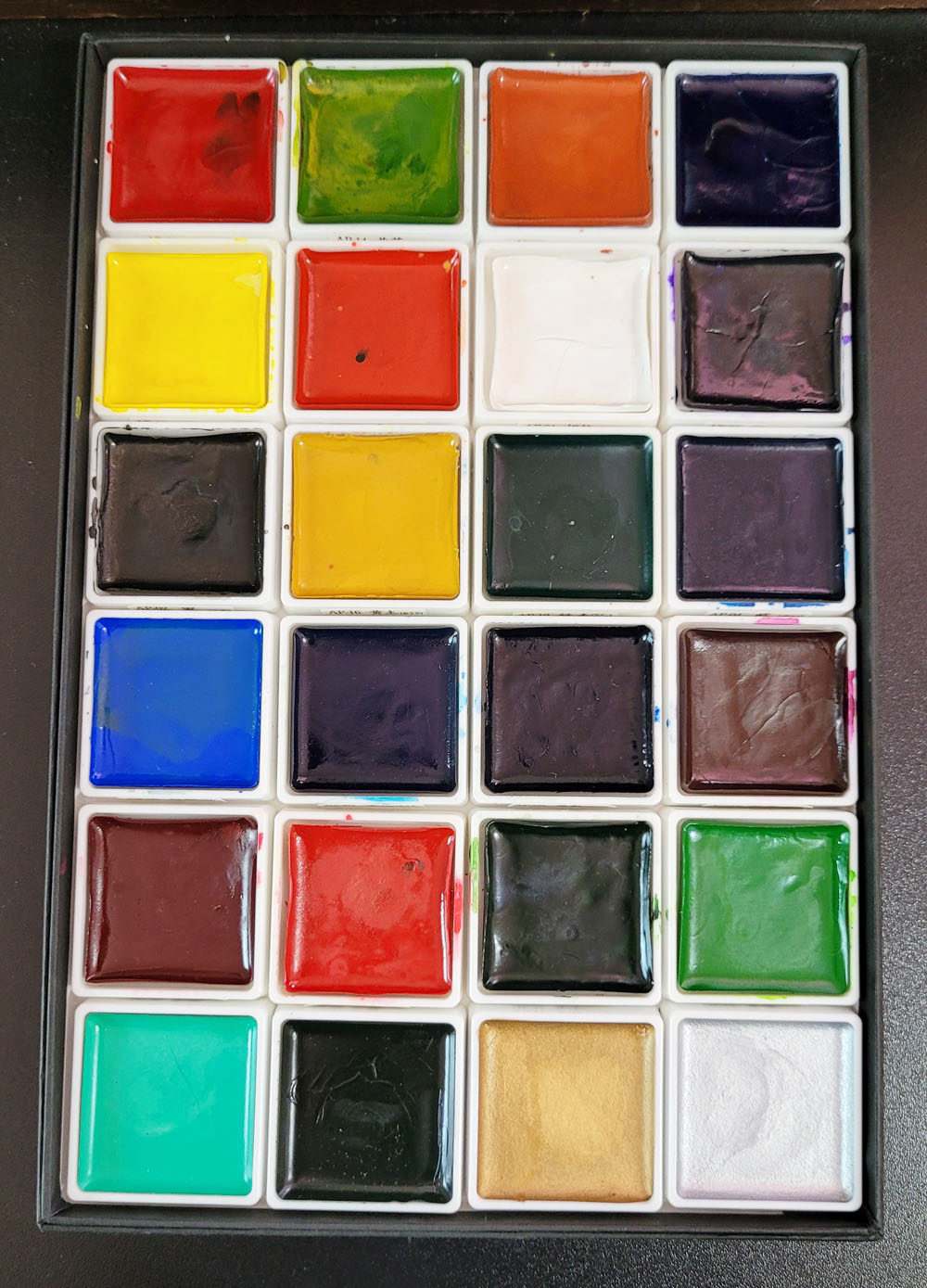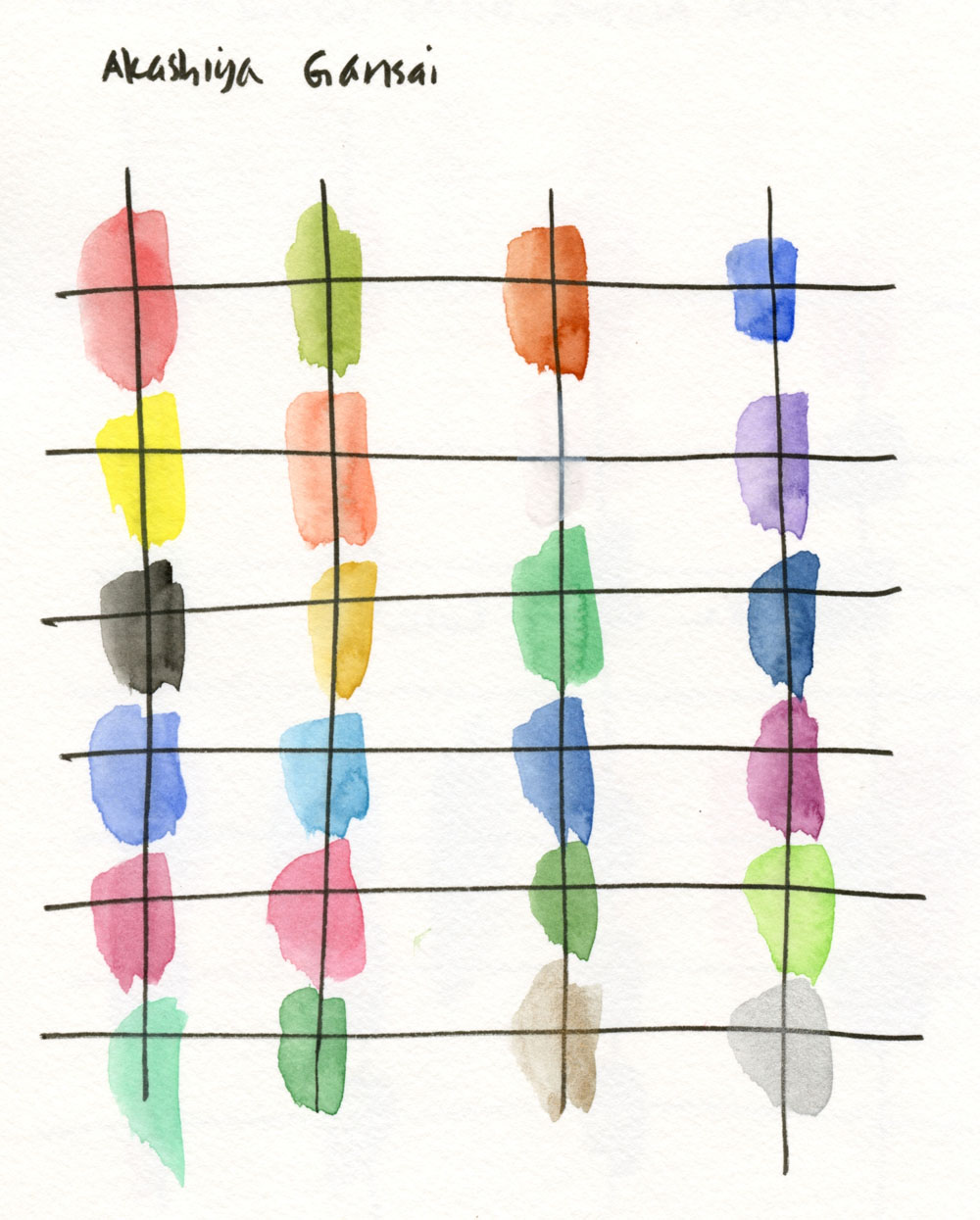Review by Tina Koyama
I took a watercolor class a few months ago that left me frustrated. Using a limited palette of pigments, I wanted to learn to mix colors. As I tried to achieve the hues I was looking for, my paint mixes would become increasingly diluted. I’d add more paint to get a thicker concentration, but then I’d have to adjust the mix again, over and over. With practice and help from my instructor, I got better at it eventually, but I started to see the benefit of having lots of pigments easily accessible, all on one palette – without mixing!
Ana had reviewed 36 of the Kuretake Gansai Tambi Watercolors a few years ago, and I liked the range of colors I saw. Kuretake now offers a total of 48 colors, sold as a single set or in two sets of 24 colors each. I decided to try color set A (24/$29.50; color set B is 24/$38).
Just as I was thinking about all this, I suddenly remembered that I had a set of 24 Akashiya Gansai Watercolors ($37) that I had purchased years ago but hadn’t used much. My product reviewer’s mind clicked into gear: Wouldn’t it be fun to compare these two sets!

Their presentations are very similar: Unlike what I think of as a typical watercolor set, with paint pans fitting solidly together in a box, both Akashiya and Kuretake sets are made of loose, individual pans that can be removed easily from their cardboard box and rearranged or replaced (JetPens sells open stock pans for both lines). This form factor makes them impractical for field use, as it would be more than easy to drop the box in transport and see the paint pans go flying. (Kuretake does offer a version of its Gansai paints in a portable palette.)
The upside of this form factor is that the pans are larger than standard (Western style) full-size pans, so it’s possible to use large, flat brushes to make wide washes without a mixing tray. (I also have a Sakura Koi Watercolor Field Sketch Box, but without mixing, the tiny pans can only be used with small brushes.) The Akashiya pans are 1 3/8-inch squares, while the Kuretake pans are 1-by-1 ¾ inches.

Both products consist of artist-quality, lightfast, non-toxic paints. They are made in a traditional Japanese way that can give the result a slightly glossy, opaque finish when heavily applied. Like watercolors, some pigments are more opaque than others, but I wouldn’t say any are as opaque as gouache.
My Akashiya set is more than 10 years old, and some paints have cracked and shrunk so that they are now loose and rattling around in their pans. I don’t think the paint quality has degraded, however. I’ve sometimes seen aged gouache pans shrink in the same way, so perhaps these watercolors contain some of the same binders as gouache.
Akashiya helpfully puts the color number and name on the side of the pan for easy viewing (but unhelpfully in Japanese only).

Kuretake includes the same information in both Japanese and English on the less accessible bottom of the pan. It also includes the number and Japanese color name on the box tray itself. This feature I find less useful, since I might want to rearrange the colors to suit the way I work.

Next I’ll show the color ranges. Each set includes a blank color chart on the inside of the box lid for making swatches. Unfortunately, in both cases, the cardboard lid’s paper doesn’t show the colors to best effect, so I made additional swatch charts in a Hahnemühle watercolor sketchbook. The black grid lines are intended to show opacity (and apparently, I can’t count when I’m drawing lines).
Akashiya colors:



Kuretake colors:



In general, this Akashiya palette is more muted, while the Kuretake set is more saturated. (Kuretake’s Set B looks like a more muted range.) Interestingly, the Akashiya set includes metallic gold and silver, which are unusual in any watercolor set.
With basic comparisons done, it was time to put the pedal to the metal. I had just purchased a bright bouquet of peonies from a family of flower growers who have a weekend kiosk at our neighborhood gas station. Despite my initial impressions from swatches that the Akashiya paints were less vibrant, I had no problem achieving intense hues in this sketch (the rough lines and marks you see on some flowers were made with watercolor pencils). My method was to dip a Kuretake water brush into the paints and apply them directly to a Stillman & Birn Beta sketchbook page with no mixing or blending except as it occurred on the paper. Looking at my swatch sheet as a color guide, it was fun not to otherwise test the colors first to see if they were “right” (which I am constantly doing when I mix in a separate mixing tray). Aside from my enthusiasm resulting in a bit of overworking, I was happy with this test sketch.


The following weekend, I bought another bouquet, this time to take to the cemetery on Memorial Day. Using the same methods and the same water brush and sketchbook, I painted the bouquet with the Kuretake set. This bouquet had lighter pink blossoms than the first one and a challenging white peony, too. I was thrilled by the hues I was able to achieve with no laborious mixing. And even though the paints look intense in my swatches, giving my water brush a squeeze as I dipped into the paints gave me nice pale tints for the lavender and pink blossoms. Again, it was great fun being able to simply dip and paint without all that mixing fuss! In fact, I know now why I like to paint this way – it’s more like using colored pencils!


Looking at the two sets together, the palettes complement each other well. I like the selection of greens better in the Kuretake set, but the Akashiya set includes some lovely muted tones (not to mention gold and silver). I don’t think I can say one is better than the other in terms of quality, so the choice is more a matter of colors included in the sets. In terms of packaging, I prefer the Kuretake’s tray, which may be slightly more secure than the Akashiya box, which has nothing but the box itself holding the pans together.
Some would point out that it’s more economical to buy tube paints and fill my own empty palette. But what’s the fun in that? Both of these Gansai (which means “vibrance”) sets are the colored pencils of paints: An instantly gratifying rainbow in a box. Get yourself one for the next time you feel compelled to paint a bouquet (which I heartily recommend for an immediate lift in your spirits).
DISCLAIMER: Some items included in this review were provided free of charge by JetPens for the purpose of review. Please see the About page for more details.
 Tina Koyama is an urban sketcher in Seattle. Her blog is Fueled by Clouds & Coffee, and you can follow her on Instagram as Miatagrrl.
Tina Koyama is an urban sketcher in Seattle. Her blog is Fueled by Clouds & Coffee, and you can follow her on Instagram as Miatagrrl.


Great review, and lovely paintings!
Thank you, Hortense!